#17mil
Explore tagged Tumblr posts
Note
Draw twobit in a kawaii dress

hope he's kawaii enough for you

#WAJAAYAYYY???? THIS TOOK ME UNDER AN HOUR???? (57mins)#maybe because I didn't add 17mil details#I should add hair clips#there#two bit#keith mathews#two bit Mathews#the outsiders two bit#two bit fanart#the outsiders fanart#art#digital art#artists on tumblr#the outsiders#willy's silly billies!!
8 notes
·
View notes
Text
I've been cackling with delight this whole time of Grand Run so far, this is amazing.
152 my literal first shift (48/51/53).
I played just one shift and came back to the big counter going from 0 to almost 2mil.
Pretty much any time you leave Grizzco for a minute or so and come back (not playing a round, just stepping out the building for a bit), you can watch the big counter shoot up like 2-4 mil at least, sometimes higher.
#post#splatoon 3#grand run#we're definitely going to not just hit the 700mil quota but also totally max out and break that counter#only 30MIN into a 48 HOUR event and we're at 17mil
5 notes
·
View notes
Text
algo que me parece un poronga en cdm new gen es el concurso de estilos, el juego esta bueno y el que puedas compartir prendas y que te recompensen por eso tambien, pero el sistema de votacion favorece al que vos crees que esta ganando, no al que te gusta y siempre son los usuarios que compran los packs, te llenan de prendas que nada que ver con la temtica y la gente vota porque no quiere perder la recompensa
0 notes
Text
State of California
I already implied multiple times how different yet imperative California is now in the BNHA-AU. How now there is a new ethnicity due thr mixture of Latin and Anglo (mostly Latin culture) culturr including a new language, how there is a new religion originate from here that now dominated Latin America, and just how different it is from today.
California is still have some similarity from today however; Sacramento is still the capital city with Los Angels still the most populous, it has the highest population (more than 80mil) and most powerful economy in the Union, and still important in the West Coast. Texas is still in second when it comes to population (around 50mil) and population, but ¯\_(ツ)_/¯. California also has the highest rail passengers by state alone, maybe similar to Japan ridership. It is likely it is only beaten by the Northeast corridor, but that region should have a population already at 100mil.
Geography
There is not much change when it comes to geography. It is not like there suddenly are topical rainforests (California actually has temperate rainforests). However, thanks to activists, technology, and laws, many damage to the environment by the Climate Crisis were alleviated. Many Redwood and Sequoia trees managed to reclaimed historic range and then some. There are bisons roaming California, too, with extinct animals brought by to life like mammoth and ground sloth, and mythical creature. California also change their agriculture practice, emulating how Dutch cultivated their products, using greenhouses, hydroponic for efficient water saving, etc. I not going get into more detail (go watch a YouTube about Dutch farming), but this method allowed majority of Central Valley be reclaimed by nature, making the land looks like what it did in the 19th century: Lake Tulare is now permanent, marshlands and has a huge delta.
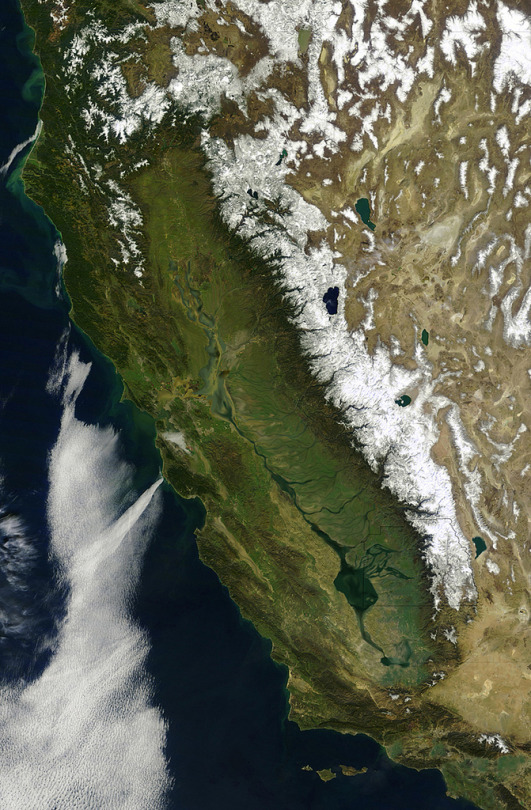
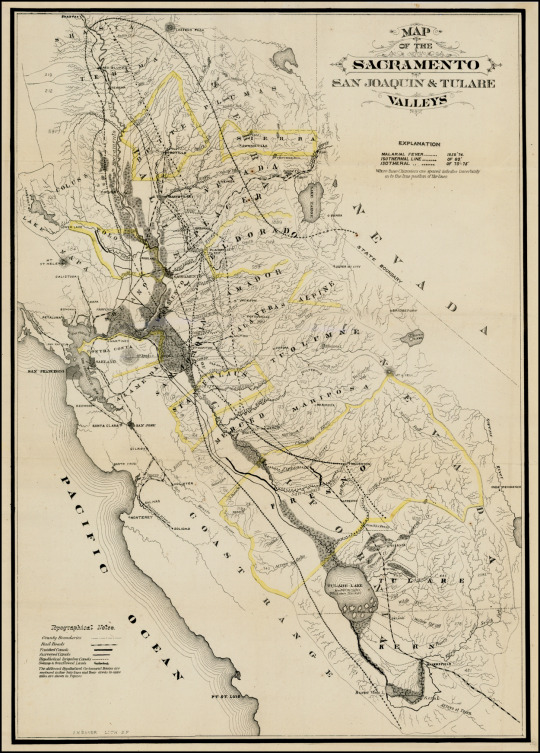
California also deurbanization (actually desuburbanization) many sprawling cities across the state. For instance, the cities I used to live in -Brentwood and Discovery Bay - are now gone, paved out. Many cities, especially in CV, have greenbelt, which also act the limited of their jurisdiction. I also think, with the Climate Crises alleviated, sea levels will drop by a meter or so, so now half of San Francisco Bay, especially south of San Mateo Bridge, is gone, mostly just salt marshes (and no, there are laws forbidding development on it).
There is a bit more rain due to El Nino and La Nina weather system now having a precedence. Like 2-3 years Nino and then 2-3 years Nina. So there could be a drought season. However, those also mean there's a lot more run, even during the mid-spring to mid-fall in Nino. Tropical storms are not uncommon during Nino, at least 1-2. This also means California will lose like a quarter of their desert are gone, so Antelope Valley and San Bernardino Valley biome are similar to Central Valley.
Cities
Bit difficult to talk about cities since some cities changed their name, some new ones, and that I need to make a map. I gonna try to convey the city position by only referring high population, North to South.
Redien- (Redding)- 500k. Know for rail connecting to Redwood Empire Corridor and to Oregon, high percentage of non-Kalifornáns, and high population of Therians/Lycan (Enid lives here).
Bí-Sierra (changing the name)(Chico) - 400k. Know for: ¯\_(ツ)_/¯
Yebu -250k. Know for: ¯\_(ツ)_/¯
Sacramento - 5mil. Know for being the capital, HQ of Golden State Railway Company.
Metropolis of San Francisco - 17mil. Know for the birth of Califity, Memorial of Califia, Angel of the Bay Statue (looks like a Japanese woman wearing a kimono, also know as Liberty of the West)/Museum of Asian and Latin Fredoians between early 19th century-1950s and Beyond.
Amid-Tu-Rifã (changing the name)(Stockton)- 500k. Know for looking like Venice and Amsterdam.
Tuolumne-ín-Estanislao (Modesto) - 500k. Know for: ¯\_(ツ)_/¯
Santa Cruz - 120k. Know for beaches and UCSC.
Salinas -1.2mil. Know for just having an HSR train.
Monterey -90k. Know for the aquarium.
Lafenia [Lafenã means Lavander in Californin (Madera)] - 3.5mil. Know for having the HQ of Rolosron (Golden Iron) Company (focus on rolling stocks), SU Laféna (focus on urban design, transportation engineering, and architecture), and vocation on public transit course.
Fresno - 3.2mil. Know for not being Fresno anymore and a dry port (ironically, it's adjacent by a massive river).
Nés Nakiśa (City near Visalia, between Tulare and Tipton)- 2.5mil. Know for being named after Nakiśa the Lover, the Innocent, and the Miracle-Worker.
Nés Anaís (Bakersfield)- 3.7mil. Know for being the birthplace of Anaís, the Lover, the Guardian, and the Martyr.
Santa de Nagasaki, also called Sanagi (in Santa Maria Valley) -6mil. Know for being a cyberpunk-like city (dont know if that's a good thing or not), cyberware and powered suits industry, and the few pro-hero academy in the world meant for non-quirks. It was a former city-state between the Dark Age to 2200s.
Santa Barbara- 200k. Know for just being a nice city.
Metropolis of Los Angels - 24mil. Know for the Gate of Angels (mixture of Brandenburg Gate and Arc de Triomphe, at San Fernando City), Los Angeles Central Station (mixture of Penn Station and Grand Central Station), Los Angeles Grand Park/The Meadow (bigger than Central Park and Golden Gate Park, at the former city of Compton, adjacent to LA River), The Sequoia (think Tokyo Skytree, have branch-like Observation deck, 670 meters tall, somewhere between Mid-Wilshire and Koreatown).
Rifãsíd (Riverside)- 500k. Know for ¯\_(ツ)_/¯.
San Diego- 9mil. Likely just the same as today.
All together, this brings it up to 78 mil people. There are other cities, towns, and villages in California like Eureka, towns around Lake Tahoe, and others around, but theses cities are considered either major, well-know, or important. All these cities, with the exception of Santa Cruz and Monterey, are connected by NAHSR, and Sacramento and Los Angeles are connected to the Continental wide Maglev network. I gonna explain California railways network later.
Most of the cities kept today boundary, however demolishing many of its sprawling suburban housing. Like I said before, most cities city boundary are tangible by its greenbelt, and they can't, by state-law, develop pass it unless their km density passed 25km, which many city, especially in Central Valley, haven't pass it. Actually, many cities in the Valley have an average of 250km land areas, with average of 12k km2 density.
Many cities, but especially to SF and LA, have patches of urban forest. Not parks meant for recreation, but forest that is meant for nature. SF and LA have many patches of those urban forests, many usually 1 km² but could be higher than 100 km². They used wildlife crossing to connect them all.
Many cities looks like a mixture of futuristic architecture (I will talk about that later) and somewhat traditional-like like Isabelan architecture (eclecticism of Spanish Colonial and SF-like Victorian architecture, need to talk about that). However, Sanagi is just straight-up cyberpunk city, like I will call it Capital City of Cybernetic, with having an unusually higher percentage of Non-Quirks. Non-Quirks are more likely to installed cyberware than Quirks, to the point majority of their bodies is cybernetic. (Lets not kid ourselves, with BNHA having robots the size of skyscrapers and artificial islands in the middle of the ocean, yeah they will stereotypical cyberpunk technology.)
Economy
I think I hinted this before, but California, and frankly majority of the world are what I considered social democracy, or at least, some form of socialist. In California (and Fredoia), almost every necessity goods or service like water, energy, internet, healthcare, public transportation (including airlines), etc. is own by the government. Meanwhile, some that considered necessity but needs some in-hand by the people like housing (majority of it), foods, etc collectively owned either by neighborhoods (districts), groups, or guilds. Now I think about it, it kinda similar to Post-War Britain, especially how it comes to Attlee policies.
In California, the state has a market socialism and guild socialism (Democratic Socialism). There are companies that are controlled by employees; democratically elected company leaders, a 1 to 5 ratio wages, input how the company should be headed, etc. Half the company stock is owned by the employees, and the other half is owned by the local governments, which is then controlled by the people. They voted how the stock revenue should be allotted and apportioned accordingly (either funding for transit, schooling, maintained, etc.). However, sometimes, thanks to public banks, they will give denizens the money through all the stocks in the city.
For guild, sometime a mixture of labor unions, company of laborers, or craftmanship. Many cities have guild in it jurisdiction. For instance, and this I have an idea for a while: biking is considered a one major ways of transportation in California. Because of that, bikes is a huge industry in the state, bikes repairers and retailers are common in cities. A guild that focus on biking will required those to join to and gain a permit. The permit is meant for laborer protects, universal bike parts, . Meanwhile, customer who have a warrant for the city bike guild could go to any bike repair: if they broke their bike kilometers away from their usual repairers, they could go to a close by repair shop and have it fix free thanks to the guild warrant.
Another city guild/company is like a group of crafter who also works together, but unlike something like a bike-like guild, it act more like a company whose own/control/manage by the city, like for construction company. It will be more efficient since the city will have experience with laborers, more efficient in talks and shit, and if there is unneeded constructions, many laborers will simply be put on paid leave (which kind of unnecessary because California is always either building or maintaining something lol).
Agriculture is owned by small farming communities. Honesty, they likely lived in Tipi-like housing similarly what I talk about in my last post. Their farming is just straight up just like the Dutch, which give higher yields for hecto without needing to use more lands. The government will give the community findings and buy their products so to keep foods extremely low. the government will then sell it, low price, to merchant/retailers who then sell it to consumer in again, low price. However, 1/3 of foods product in California is grown by urban farming.
The majority of housing is collectively controlled by locals/tenets. I based it on Singapore town council and House and Development Board. I know that anyone who knows about this is probably not a good thing, but the other synonymy or trying, think of example is Homeowner Association, which is worse. Each city (or ' special wards' for metropolis cases) have districts, which democratically handled housing (and other buildings). They also have delegates for the city council. The district receives tenets rents and is handling it by either paying utilities, repairs, or insurance (not like insurance company, "just-in-case" like natural disasters, hero/villain's battle, etc.). Prices are dependable on housing types (a duplex will be more expensive than an apartment, while a town house be more expensive than a triplex), rooms (if you have kids, the price will be lower), floors, material of the building itself, and construction method. But price are all fixated, meaning if there a housing that have all the characteristic in two different location, and one is consider far more desirable for its surroundings, the two housing are still the same price. In today markets, we usually handle this by outbidding another buyer, which increases house prices. This is the reason why San Francisco is so expensive. Instead, California housing is handled by a lottery system, fairness by fate instead of higher monetary. Some participant are allowed to have some advantage depending on their situation: if they live in the district/city majority of their life, if they have a family, they lost another lottery, they are about to be homeless soon, and such. Ironically, Frinsica (San Francisco) is still difficult to get a house there, lol.
In housing there, people either rent or buy housing. By renting, it usually cheaper- if we using today renting price, an average price for like an one room apartment will likely be $150 per month (people have limits of free utilities until hiting that limit. Parking isn't included and is optionable since like more than half of California doesn't have a car). It's for people living short-termin the area, occasionally students for either high school/college who doesn't want to live in dorms/SRO, newly adults, or people who simply want an easily life (which is not stigmatize in California). However, it usually has a maximum limit of how long someone could rent there (usually 5 years), so people are either evicted or pay an expensive extension. Buying a hosing is also preferable and also cheaper than today. I don't know what is considerably an average price, but likely a triplex unit will cost $150k (you not owning the entire building, just the unit. You do collectively share it with two other owners). Buying is likely similar to how Singapore housing (go look at a YouTube video, lol). One thing to note is that the owner cannot sell their unit or rent it to another tenet. They could only sell it to the district, which would likely be the same price with 5% add. The owner could allow their unit to be inherited or allow friends/families/associates to live in it, but that likely it. Selling or renting it will defeat the purpose of a lottery system.
There is a national bank, a public bank owned by the federal government. Each state have their own banks which connected to the federal bank. The benefits is there is no monthly fees, withdrawing money from other state bank atm without fees, easier gaining loans with lower interest rate (great for starting business ), better retirement account which also connects to social security. However, there is a limit how much someone could have in their account before they start paying a monthly fee: $100K, and the fees gets much higher along with the saving account. (Also, it is common for people to have two retirement, the average lifespan is 160 years, and there are also quirks that allow some people to have longer lifespans).
For artisan guilds like for writers and artists, there is likely an universal-like wage so writers/artists could allow to do their craft. However, there is likely a quota/requirement so they actually do what they meant to do.
For exports and well-known sectors, it likely will be the same as today with some key differences. For one, they know for rolling stocks, specifically for HSR, metro rails, and trollies. The company that handles it, Rolosron, is located in Laféna. Another is Kalimé, or sometimes called Kaliniśon, animations production in California. It has their own unique style, similar to anime in Japan: inspiration, and how I think it will look like are SPOP, Gurihiru works, and some comics like Specter Inspector. Produced in either Los Angeles or San Francisco. Cyberware is also well-known, many of which are produced in Sanagi. Maybe also biking manufacturers, revenues from Califinitan pilgrims, and likely that it.
Half the main energy source are renewable, including solar energy, wind energy, ocean tide, and hydroelectricity. The rest is nuclear fusion plants, and when I mean plants, I mean there are only four plants in the entire state (they needed imported huge amount of tritium gas, also yes, there are still fission plants). There are also room-temperature superconductors, which it is not as common so its usually use for either fusion reactors, transmission tower (almost all California's wind power comes from the Great Plains), energy storages for cities. They are also getting into the noireau (metallic hydrogen) industry.
California working hours is 6 hours, and could only work for 4 days. Cause of this, they have 3 day weekend. In Califinity, they viewed that person must time in three order: Friday for resting, Saturday for indulgence, Sunday for praying. They also get 2 four weeks vacation and 1 three weeks of vacation.
Transportation
YEAH! This is the one I waiting for; I keep indulging about California having an intricate rail network. For now, I gonna talk about non-rail transit because I dont fuck around with trains.
The majority of California used rails for transportation, with Los Angeles rails having 28mil passengers in a city of 24mil (wondering how, go look at Tokyo transportations section in Wiki). However, there are many people who also use either the bus or are preferable to either walk or bike to their destination. There are people who uses cars, but it a privilege to use it, and expensive too: there is congestion charge, parking fees, registration fees for battery cars, high taxes for either ammonia or noireau fuels , and high tolls for using Interstate/Expressways (maybe like $1000-1500 for per year, and higher for freight trucks) (many freeway/interstate were demolished in inner-cities however).
Not only that, many cities have streets design that are similar to Tokyo and European cities: having few boulevard that connect the city in boarder scale, but have streets that either one-way, or pedestrian only zone.

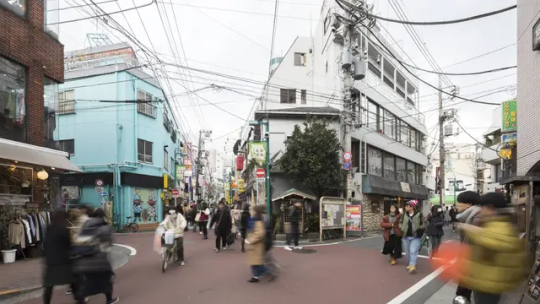
This kind of street are very common in California cities.
California owns a state-enterprise airliner, Golden Airline. There are only 5 major airports in California, 3 that deal with international (as in, non-UNEC member)/intercontinental destinations): San Francisco International Airport, Los Angeles International Airport, San Diego International Airport, East Bay Transcontinental Airport (Oakland Airport), and Santa Ana Transcontinental Airport (John Wayne).Not only are there fewer airports, but intrastate flights are banned in the state. Thanks to federal law, constitution, and UNEC, flights are also banned to Oregon, Nevada, Arizona, Navajo-Hopi, and the State of Baja California.
Rail
California owns a state-enterprise that deals with rail passengers called Golden Railways Company (HQ in Sacramento). Actually, it is one of seven subsidies of Amtrak, which is far larger than today, to the point there has to be smaller companies to deal with railways. The other is Lone Star Railways (Texas and California are the only states to have their own railway companies; HQ in Austin), Northeast Railway Company (Northeast region including Maryland and DC, HQ in New York City), Russet Railway Company (Midwest States that isn't under Lakotah lands; HQ in Chicago), Cascadia Railway Company (Oregon and Washington states; HQ in Olympia, WA), South Railways Company (can't think of a good name lol, compassed all other Southern States; HQ in Atlanta, GA), and Sunwest Railway Company (Southwestern States including Idaho, Montana and Wyoming (any left over lol); HQ is maybe either in Phoenix, Santa Fe or Denver).
California has a massive railway network; it's possible to go to any destination via rails in the state, via regional corridor like the Redwood Empire Corridor (talk about that soon), or intercity/hsr. California two important corridors; the Golden Corridor that goes through Central Valley all the to San Diego (and connects to other states and countries), and the Southern Range Corridor (also called Salinas) that started in San Francisco, goes through Salinas Valley, to Sanagi, Santa Barbara and then Los Angels.
The Golden Corridor used the legacy route of CAHSR, a project that, despite its flaws, was fundamentally crucial for the state. I gonna digress for a bit but people bitching about how the route "should be shorten" or go pass certain cities missed the point. California does not have a good connection with its cities. Yeah, there is Amtrak, but the issue is that it is too slow for conveniences, many of its tracks are owned by freight companies, and there are no direct routes for SF-Fresno-LA. The reason why there is such high population in Central Valley is thanks to CAHSR (and other things). The only reason there is some route change is because there are always things to improve on, some cities are just gone, and there are other routes that don't need HSR.

(What the majority of GC looks like)
There is some new routes and changes of route. For one, it goes further norths to Chico, Redding, and then to Oregon. Another is the corridor at SF-Jose. Right now, CAHSR will share with Caltrain, using the same rails. It is great because it electrified the rails. However, there are some flaws. There are still level crossing, which, admittingly, some are being constructed to have grade separation. Another issue is that it has double-track railways, and it's in the middle of an urban environment.
A few decades after Califia's death (maybe 2080s to 2090s), California has somewhat of a rail revolution, transforming the state railways. For one, the state converted half of state route 101 (SF-Mountain View) into quadruple-track railway. The benefits that it allows HSR trains to go faster, allowing other trains to share (the Bay Area has a RER/S-Bahn trains), and is more separate from urban neighborhoods. The corridor split off from MV: one goes to San Jose Central Station (dual-track again), another still going along US101 than merging with IS880 (still a quad-track). The former Caltrain corridor is converted into a BART line (which is owned by BATA- Bay Area Transportation Authority/likely succeeded Seamless Bay Area). Once the corridor enters SF, it follows the same route of US101 (there is now freeways in SF), which, instead following CAHSR terminating underground, it goes to SF Central Station at the former IS80 above ground. It's a through-station and follows into SF-O Bay Bridge, which either goes to Oakland 16th Street Station, or continues to Sacramento. The Bay Bridge (Golden Gate Bridge and San Mateo Bridge too) itself is similar to New York Manhattan Bridge and Brooklyn Bridge: railways in the bottom, 3x3 road, and a pedestrian/cycling route atop.
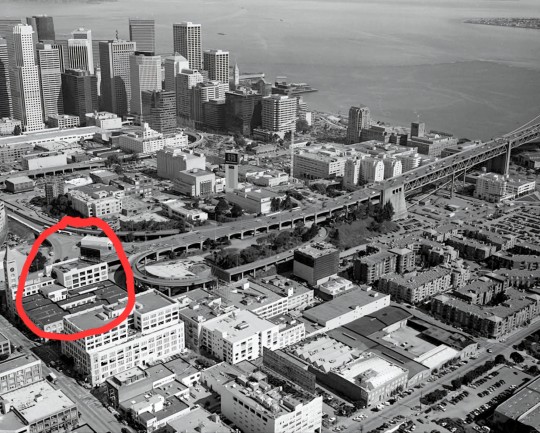
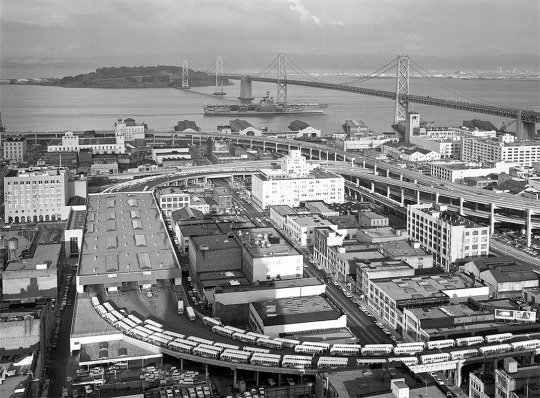
(Where SF/Frinsica Central Station will be located. Also note this is the only way for cars to enter the bridge. Also, i am hitting on my image limit, lol.
For the majority of the corridor, from Sacramento to San Diego, the majority is quadruple-tracks. Well, maybe six-track if you count Maglev, it fellows the Golden Corridor. Also, San Francisco is the largest city in Fredoia that doesn't have a maglev station (lol, lmao even). Some cities are gone, so the corridor does not stop there. Kings/Tulare is Nés Nakiśa, the one near Visalia, and then to Nés Anaís. If a city is adjacent along the corridor, it will have a station, but the HSR will bypass it. There are also minor corridors that connect to the Golden Corridor. Best metaphor, the Golden Corridor is an artery that connects capillary.
After Bakersfield, it bypassed Palmdale and continued to Burbank/LA. Like I said before, Palmdale is connected to the Golden Corridor and does have it own Corridor, its only that HSR does not go there. After LA, it continue down south; it does not go west to San Bernardino. Instead, it continues journeying to Anaheim and then cutting through Chino Hills towards Riverside. From there, it either goes to Las Vegas and/or Phoenix and/or Jeddito and the rest of the country. Or it continues to San Diego, Tijuana, Mexicali, and then all the way to Mexico City. It is quite common for Californians and Mexicans to travel for either places thanks to UNEC having a open border policy.
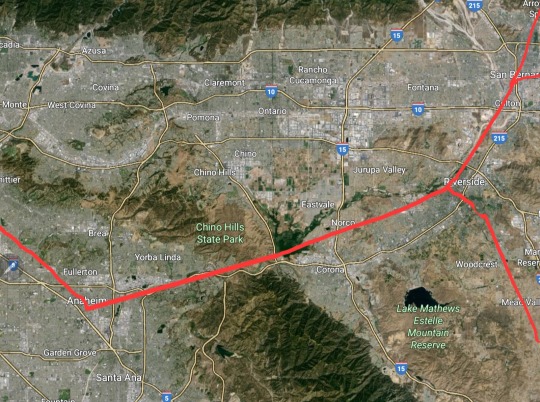
(Notices how once stopping at Riverside, it either goes south, north, or northeast). (Also, I mention before and forgot to said it here, HSR can go up to 450 kph (average likely 400 kph). How they achieved this, other then making sure the corridor is as straight as possible is by: having wireless power transfer beneath the tracks (not eroding the overhead lines), concretene (concrete that has graphene mixed in it) to withstand the vibration and have longer lifespan, and nistíl (neo-steel which is my own idea; just steel itron mixed with graphene) which also withstand the vibration, friction, and have a longer lifespan).
The Southern Range Corridor, or the Salinas Corridor, is another corridor that meant for HSR. The Golden Corridor became extremely congestion: not only regional and HSR trains are using it, but also interstate and international trains frequent the route. So GRC constructed another corridor (likely in the early 2200s) to alleviate the main corridor traffic. It also has many cities in this region, especially Salinas and Sanagi, that don't have proper train lines. The corridor started from Gilroy. Instead ofgoing east, it goes south, going to Salinas. Then it goes southeast through Salinas Valley, continuing all the to Paso Robles. Then it goes south through the mountains, going through San Luis Obispo, then stopping at Sanagi (Santa Maria Valley). It then goes southeast again to through another hills, stopping at Santa Barbara, then through the mountains again to Ventura, goes to Oxnard, Camarillo, and then to Los Angeles Central Station.
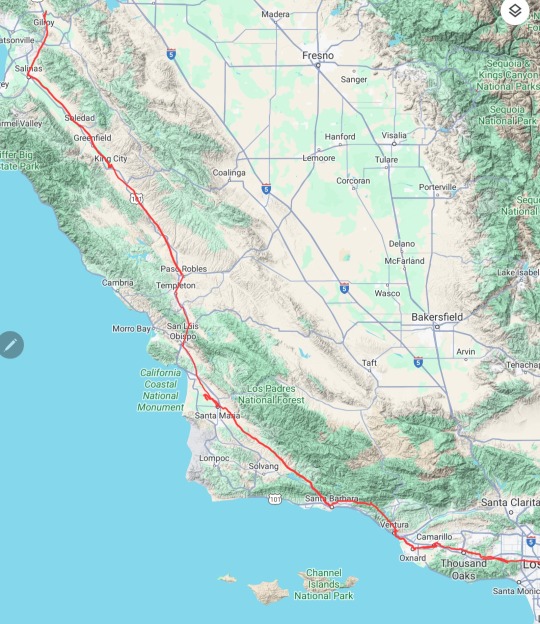
(What the corridor looks like)
Now, the Golden Corridor and Salinas Corridor aren't the only corridors, but those two are the most important, having HSR lines and high traffic. There are other corridors in California, local/regional ones that connect to either corridors. Small traffic yet crucial. One corridor I want to talk about is the Redwood Empire Corridor.
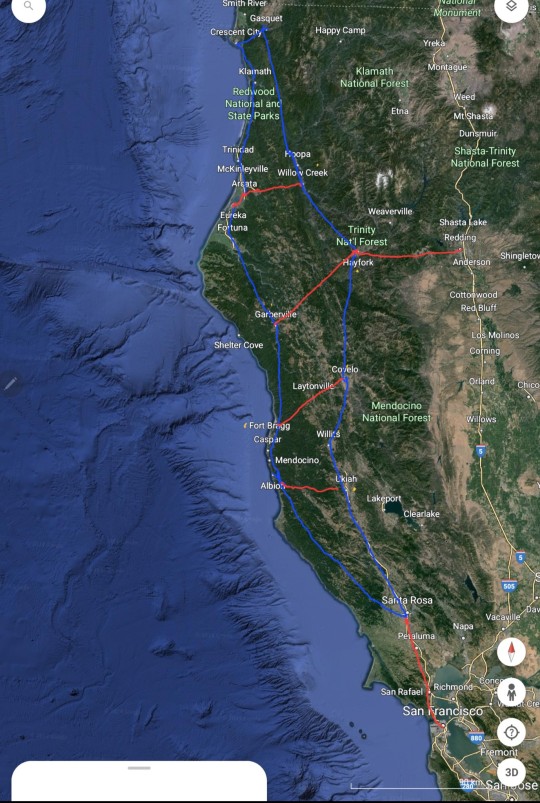
(red is dual-tracks and blue is single-tracks)
The Redwood Empire population, minus anything south of Santa Rosa, is around 750k. Once past Santa Rosa, the corridor goes in a counter-clockwise. The red that goes east-west allows the line to form a 0-shape route. There is like an average 15-20 on the line. I got the idea from Not Just Bikes video about Switzerland. Thanks to this, there are far more people who travel to Redwood forest, especially in spring and summer. There are other corridors in low-populated regions that use similar routes.
The state entire uses clock-fast scheduling- arriving or departing either at 0s or 5s- and pulse timetabling.
There are different categories and types of rail trains, basing it off from Germany and some from the UK. The reason why those two is because it's the only one I can find in Wikipedia, lol. Usually based on how important the hub is, intermittent trips, number of passengers daily, and huge the building is. If I properly made a category list, LA and Sacramento will be 1 (having a maglev stop) while San Francisco and Lafénia will be 2 (not having one. Also, being the last stop before an important junctions is the reason why Lafénia has such a high population).
Education
Before I startn I need to remind everyone that the average lifespan is 160. This means that people ages slower, including sexual maturity like some animals like giant tortoises and bowhead whales. So there people in their 50s who looks in their 20s, or in their 90/100s who looks like in their 40s, similar like Aragorn from lotr (this also means women/afab are averagely 2-3 inches shorter than men/amab, and menstrual cycle is 60 days. Average Ostrace age is usually 200-250 excluding Kitsune and Sanguinarians). So schooling lasts a bit longer than today. (Also, California schooling is implemented country-wide with some difference.) There are laws that require schools to be surrounded by pedestrian-only streets. School days are Monday-Thursday. Some schools also have Friday but it is only half-time
There is 4 levels based on age:
Elementary school, also have daycare :0-8
Primary School: 8-12
Lower Secondary School: 12-16
Upper Secondary School (referred to as Liséa in Kalifornán): 16-20
Elementary schools are far more common than the other 3 schoolings, with an average 1 elementary per 1.5 km. The reason is that is so young children could be closer to their schools. It compassed pre-school, kindergarten, and Grades 1 and 2. Elementary teaches students their primary language (Kalifornan), basic math, and such. An average elementary will likely have a body of 100-200 students, with teachers having a class of 8-10. The elementary playground will also act as a local park. Elementary students are also called Ducklings due teachers picking up their students and herding them to schools like a parent duck and students wearing bright coats.
Primary schools are a bit more widespread due to students being supposed to act more independently, maybe like 1 per 5-10 km. Students are supposed to learn their second languages (usually either English or Spanish, but in some cases, a different language if the neighborhood has a large non-Californian population). An average class has 10-12 students with 500 per school, and students stay in the same class all day. Parents pick their child schools. Schools last 8:30-1:30
Lower Secondary School is widespread too, with 1 LS per 10-20 km. Students again will learn another language, learn more complex subjects, and such. Average classrooms are 12-16 and like PS, students shared same classes. Students are allow to pick their schooling when entering Lower School. School last 8:30-2:30.
Upper Secondary School (or Liséa in California) is far more widespread, with 1 per 20-40 km. Unlike the last three, students do not share classes but go to classes individually. UP acts more like a university than the other schools. Students may learn another language, but it is not mandatory. Not only students may choose their schooling but they could go to another city's schools if desire. It is common for students from small cities and towns to go to bigger cities like SF and LA for schooling (staying at either schools' dorm, social single-room occupancy, or renting an apartment). Students also gain a counselor who guides them for post-US life and careers, especially if it's related to their quirks. It is dependable on the student's schedule, but Schools last 8:30-3:30.
From Primary to Upper School, all students are required to wear an uniform. However, dress code is only not strict but students are courage to customize their uniform, embracing California social individualism. Gender restricted is illegal, and students, regardless of gender, are allowed to wear either pants or skirts. In fact, it is common for boys and masculine genderqueers to wear skirts during summer classes.
Classes scheduling is dependable on cities and their school district, but there are causes where classes have hybrid scheduling of Block and Timetable, with all 8 classes the first Monday, and A/B for the rest of the week. However, some classes, like language and math, are required to be held daily. A school year lasted from late March-Late June = 4/5 weeks vacation= Early August-Late Nov./Early Dec. = 4/5 weeks vacation = Early Jan - Mid/Late Feb = 2/3 weeks vacation = New School Year.
There is a new legal status called Minor. When a student/child reached the age of 15 years-old, their legal status will be listed as Minor, a transition from childhood to adulthood. Under this status, they enjoy far more privilege than they did as a child:
Allow to consume alcohol that is under 5%.
vote in local election.
Go to doctors without parents permission and do minor procedures like HRT
Watch +16 movies at the theaters.
At age 20, they allowed to do:
Voted in State and National-wide election and run for local office.
Consume all levels of alcohol.
Watch +20 movies at theaters.
Allow to do major medical procedures like gender-assignment surgery.
At age 25, they allowed to do:
Run for state and national-wide lower-chamber office (upper chamber and executive branch is 35).
Join the military.
Allow to work in Pleasure Guild (adult films, sex workers).
Drive and operate machineries like cars, trucks, trains, planes, etc.
Culture
The majority of Californians are an ethnicity I already talked about, Kalifornán. Kalifornáns formed (how does a new ethnicity happen?) due to many other Latins ethnicities' culture, especially Mexicans, shared, borrowed, and merged their culture together with Anglo in California. The language, again called Kalifornán, formed from Spanglish. Kalifornáns is primarily found in California, but many are also found in either US states like Arizona and in Mexico states like Baja California.
Kalifornáns are usually energetic and cheerful, more so than non-Kalifornáns. They greeted one another with hugs and kisses on cheeks, regardless of gender (even in formal greeting, they do so, though only with other Kalifornáns). Informal and casual parties are common, lasting into 1-3 am. When guests come over, the host usually serves coffee like cafecito and some pastries. It is just like other Latin Americans' etiquette.
Small street parties are also more common, usually starting around 4-6 pm. Its due to how permits are not really required, only informing a police officer and asking permission of either store or restaurant owners if they throw one. This creates a stereotype of how Kalifornáns are always throwing parties.
Different gender and sexuality are far more acceptable and common in California, with at least 30% self-identified being queers. Even men who consider themselves cishet will wear skirts if the day is hot, and wear bright colors and showing off skin (think timothee chalamet venice film festival outfit).
In beaches and film, breasts are not stigmatized, and it's common for women or genderqueers with breasts to be top less (though some wears a wrap around their shoulder). Non-genital nudity in media is also non-censor and is known to be shown in media below rated-16. Breasts are not sexualize in California, they are more interested in hips, waists, thigh, and butts.
Kalifornáns celebrated their Quinceañera, regardless of gender. For Kalifornáns, especially Califinitans, a child reaching 15 years old, a Minor in legal status, is considered the second most important birthday of their life (behind their Awakenday). This age is considered a transition of childhood to adulthood, and so, many people celebrate their coming in age day. For girls is called Quinceañera, boys is called Quinceañero, and for nonbinaries and other genderqueers is called Quinceañere. It is commonly to celebrate Quinceañera-children all together in the end of the month, usually at a Califinitan temple, and the government pays half of the celebration.
It is common for Kalifornáns to have mini-vacation once a month or so, using their 3-day weekend. They usually preferred traveling 2 and a half hours away from their home, using HSR (hence the high ridership). It's also common for Minors, even young as 15, to have mini vacation by themselves or with friends. It also common for them to visit family or friends if they attend school in another city.
Kalifornáns usually started parenthood between their 40s-50s, usually having 2-4 kids. Parents use their parental leaves for childrearing; parental leaves could be used for up to 3 years, and both the workplace and government pay for their leave ( the workplace is only up to a year). However, it is common for parents to stay home up to six months, where either parents (or ternary or more parents) will agree upon a schedule where one either: work half day and the other take care of the child, one work full day while the other care, or do a hybrid with mixing both schedules. It's very common for families, friends, and amises (will explain that later) to help rear the child, including the community, too. Thanks to technology and different social norms, there are different ways to begotten a child: artificial wombs are becoming the most popular way, though queue are long. (For artificial wombs, gestation is much larger -16-18 months, but the benefits are that infants are more developed compared to natural ways. They will be born as a 6 months old infant and soon start crawling a month later). Vitro gametogenesis is already mainstream. Another method is synth-organ/glan: synthesizing tissue that does certain functions that can't be found in human biology initially ex: having a specific gland to filter carbon dioxide, or having freckle-like bioluminescent marks. Meaning, it is possible for ciswomen to have a synth-penis that produces estrogen and gamete and, likewise, for cismen.
In Kalifornáns, and frankly, Califinitans too, there are considered 3 important important group that fomrat into structures of an individual: families, friends, and lovers, and they all central around the person. In Califinity, one of the most important holidays (expect the day Califia death/transcendence) involves around this, celebrated in the first 3-day weekend of June (it is no coincident why it is in June). So, while romantic is important, platonic-ships are also very important. One such instance is called amís. An amís (or amise/amisa/amiśo) is someone most dearest, closest friend. A word that is similar to it is the Japanese word Nakama. Rarely will people have more than one amís. It is common between amís to have a civil union while also romantically marry to another person. Amís are known to be intimate, including cuddling, small kisses, and hugs (sex is uncommon but not unheard of). Amís will also raise child together, and sometime they will be both child biological parent. There is a genre in media that is meant for amís.
Snippet culture
Can't really think of categorizing this so I gonna type it out. Kalifornán parents don't genderize their child name. Since Kalifornán uses some Spanish rules, including grammatical genders (-a is feminin, -o is masculine, -e is nonbinary/genderqueer, and no vowels mean gender neutral; likely will use ä,ö, and ë), the parents uses gender neutral, and it's up to the child if they want a gender suffix.
It's common for children to call their parents by their first, especially if they're same-gender. For instance, Anne Boonchuy will usually call her mom Mami Oum. However, sometimes, they will have a nonbinary/gender neutral informal parent word, Parí (pair-e). Same uses if both parents are same-gender or one happens to be a genderqueer.
This isn't only done by Kalifornáns but also country-wide, but it expects for both couples to take each other's name, like how Latin Americans do so. For example, Anne Boonchuy full name is Anne Asnee-Boonchuy (Asnee is Oum's surname). Usually, women keep their mother surname and men likewise. Same-gender couple, like a sapphic couple, both will keep their mother surname and again likewise for gay men couple. Nonbinary/genderqueer couple or partner is a bit difficult, but they usually choose what name to keep or keep if one of their is nonbinary/genderqueer. There are also new surnames. (Disgressing a bit, but Emma Nolan full name is Emma Emdis-Nolan. The -Dis suffix means "daughter," and Em- is shortened for Emma. Also, she has two mothers, but she still gets disowned due to being a non-quirk (oof). Also, she has six other sisters).
There are some new dishes, one is which is sandwich/taco-like. It's similar to roujiamo (Chinese sandwich, which half the bread is halfway slice before stuffing food into) with using arepa (or any other flatbread). The bread is slice halfway, and then hallowing it inisde. Then, the ingredients uses spiced and shredded grilled meat (usually chicken), shredded lettuce, diced tomatoes, cutted green onions, maybe diced of white onions, and condiments of sour cream, and either BBQ or thousand islands sauce.
The majority of Southern California are non-Deitist Califinitans, and Northern California are Deitist Califinitans (especially in the Bay Area and Central Valley).
Romantic relationships with age gaps will likely be more common due to longer lifespan, especially if dating an Ostrace. Yoko Tanaka is likely twice the age of Divina, though Sanguinarians ages even slower than an average Ostrace. It will not be surprising if, say, a young Japanese lesbian dated a Kitsune and found out she was alive when Matthew C. Perry went ashore on Japan.
There is a balcony culture, similar to what Montreal has. Since most people in California don't own a single detach housing anymore, and that many housing has a balcony, people will convey their balcony in their own liking. An average balcony is likely a bit smaller than an average room, half which jutted out from the building. There are a lot of hanging plants, many of which are flowering that dangle from it (I based it on Cartagena historic district), and it is common to see people having conversations from across one.
Popular sports are association football that doesn't revolve quirks, girdfield that use flyers (flying broomstick) and non-mage-kind could play, and Metaball, which is the most popular sport in the world. Metaball is a quirks sport, meaning a person needs to have a quirk in order to play. The rules are malleable depending on players, but everyone is required to use a soft exosuit. Capture the Flags is also popular, which is mostly a pro-hero game that heros, usually forming a team based on their cities and playing against each other. The game could escalate very fast, and it is popular on pro-hero academies.
Don't know what else to talk about. The justice system is vastly different, like police officers (other than requiring to have some sort of degree) can't carry lethal arms. The US has a gendarmerie force, the National Guard, which revolves usually against highly dangerous quirks (justice systems are not allowed to use the term "villian")(raiding, capturing, and transporting), internal security, and all that stuff. Pro-heros operate differently than Japan, which are like private cops. Pro-hero is another branch of the National Guard, meaning it's a gendarmerie, different from that they focus more on their quirks individually. Pro-heros usually are put in team, squad, and operate individually and occasionally as teams like Justice League and The Avenger. The highest ranking team in the US is called Liberty Paladins, which usually involves protecting both the prime minister and president, dangerous missions, and stuff (California hero team is called Golden Costodian). Also, during the time of war, Peo-heros will act and operate like soldiers.
Pretty much that it. I planning on changing the US name, somewhat similar to Saoirse, got inspired watching a sex scene of Saoirse Ronan with Charlotte Murchison and I kinda like that name.
#bnha#boku no hero academia#my hero academia#mha#bnha au#mha au#bnha fanon#bnha fanfic#mha fanon#mha fanfic#bnha fanfiction#mha fanfiction#enid sinclair#the prom#railway#trains#high speed rail#urban#lore#sci-fi#sci fantasy#socialism#leftism#left wing#wednesday netflix#queer#yoko tanaka#divina wednesday#amphibia#anne boonchuy
8 notes
·
View notes
Text
on the one hand, i'm always right to hate walt bc he sucks and none of this would have happened if he hadn't forced jesse into the lab bc of his obsession w controlling jesse specifically, and i get that gale was an unknown element but he didn't have to control anyone he just had to shut up and cook and take his $17mil a year or whatever
on the other hand, things really spiraled out of control bc gus was pissed that jesse wanted to kill two guys for 1) coercing a child to kill his friend and 2) killing that child so honestly like of course i shouldn't root for gus but ???? i still wish jesse would just let gus kill walt like god damn mike was right man you are loyal to the wrong guy
#stockholm syndrome typa bs...#too bad nobody told jesse who's responsible for jane's death#that woulda cleared all this up real fast smh#watchin bb
10 notes
·
View notes
Text
lo rata q soy que consegui un set de cocina con banda de ollas y sartenes a 17mil pesos
14 notes
·
View notes
Text
it is so wild to me how Lord Huron has almost 17mil monthly spotify listeners now like. wdym they have Seventeen Million Spotify Listeners. where'd all those people come from
#lord huron#its super epic that theyre getting more popular but also What yknow#looking at all the new listeners like Do They Know. The Lore#<< guy who needs to do more research into the lore#anyway yeah just thinking#also lord concert tickets in the future........i dont want 2 think about it lol
9 notes
·
View notes
Text
God, I found the most bewildering category of dragons on the Auction House - dragons listed for 2,000,000,000 gems. Which is 13,333x the cost of the most expensive Light Sprite currently on the AH. And, if I did my math right, about $17mil USD if one buys all of their gems through the $100 for 11500 gems bundle.
I don't - I don't get it. Is that a flex? Look at this cool dragon I have you could never afford? Why - why?
6 notes
·
View notes
Text
Solo una breve nota para destacar algunos aspectos comunes observados en dos series asiáticas. Luz de luna ( Moonlight) calificada con un 9.4/10 entre más de 17mil espectadores. Se desarrolla en ambienta en un entorno editorial y la vida y entretelones de los autores, las editoriales y el público lector… todo envuelto en cuestiones muy cotidianas, de la vida de los personajes. Me ha resultado interesante el enfoque que le han dado desde la perspectiva del editor de libros y el papel importante en la producción de una obra sea del género que sea. Se destaca la importancia del respeto al autor y a sus fortalezas y estilo. Esto lo enfrentan con los intereses comerciales de las editoriales que normalmente ponen el interés en las tendencias del mercado y se preocupan más por lo que será aceptado por el público al punto de presionar a los autores a cambiar su estilo para llenar la “tendencia” en el mercado. Me resultó muy interesante e inspiradora. Seguro que lo es también para todos los amantes de la lectra y de la escritura. Es muy recomendable. Mi querido guardián Igualmente valorada con 9.1/10de entre más de 35 mil opiniones. Va de historias de militares y médicos militares, en el área de cardiología y urgencias. También involucran a la policia nacional. Hay mucho mensaje “patriótico” y se realza la fidelidad al trabajo, a la defensa del país, y la profunda identificación con las fuerzas de seguridad. Tanto en el personal médico como en el militar hay un gran ímpetu por el desarrollo del trabajo con excelencia y se ponen por encima de todas las circunstancias la autoexigencia para hacer las labores al máximo nivel. A la vez se exponen entre diversas situaciones de relaciones interpersonales en las que se pone por delante la fidelidad al trabajo y la pasión vocacional. Intersante las reflexiones y como se van exponiendo los traumas vividos y que explican los comportamientos de todos los personajes. Realmente saben cómo atrapar al expectador con las inesperadas situaciones cotidianas y profesionales a la vez. Los aspectos comunes que quiero destacar: La búsqueda de la excelencia profesional: en los dos casos las chicas protagonistas desafían a la familia en ambos casos a la madre quienes no están de acuerdo con que abandonen la casa y se vayan a otra ciudad, constantemente les llaman para que regresen para que no se exponan a las tantas exigencias de la vida en las ciudades. En ambos casos, las chicas tienen una profunda convicción en que hacen los correcto, siguen su vocación, sus anhelos por poner sus talentos y habilidades al servicio de los demás. Los chicos protagonistas también se exigen al máximo para darlo todo, en un caso es ponerlo al servicio de la defensa del país y en el otro para deleite de los fieles lectores. Dificultad para reconocer los sentimientos y expresarlos: Se presentan muchas situaciones no solo entre los protagonistas sino en los diversos personajes entre los que la expresión de sentimientos es casi nula. Se destaca el respeto a la autoridad de los mayores o de los rangos mayores en la línea laboral. Importancia de la familia y la autoridad de los padres: Aunque los padres pueden ser desafiados, tienen un gran peso en la vida de los personajes. ( como en todos jejeje) Y esto no deja de crear unos conflictos internos (explícitos o implícitos) que marcan la toma de decisiones. Esto creo que puede ser bastante común en muchas culturas. Lo que más me ha gustado de ambas es la manera como han sabido combinar la gran variedad de pesonajes con muy diversas caracterizaciones, experiencias, circunstancias desafiantes, independientemente del nivel socioeconómico y cómo se entremezclan con las tramas principales y dan oportunidad a los personajes principales expresar otras características. En todas las ocasiones se muestra el honor, la voluntad de automejora o incluso la impotencia y aceptación de lo irreparable. Muy humano todo. Me quedo con: la fidelidad a la vocación y el perfeccionamiento para servir a los demás desde las diversas ocupac...

View On WordPress
0 notes
Note
girl you haven't posted mine I answered to the anon that wanted to know what is Toby's work? He is founder of TB concierge with Jets hotels restaurants clubs travel and security him and Jude always fly with private jet which is Toby's work they have a contract so everywhere Jude goes is done by Toby .They have signed a contract.Toby earns 17 million pounds in a year with his clients .Jude is not his only client .Girls that want to meet Jude should be checked by Toby firstly i guess so .Since he isn't for a serious relationship he doesn't care much how does that girl look like .
I cant answer every single ask at once please be patient. And i truly do not think toby earns 17mil a year. Where did you get that from?
1 note
·
View note
Note
Hi i saw your reply on a post about least favorite songs and needed to share my pain. At my state university, there was a big announcement. BIG big. However, this announcement was a secret. They spent MONTHS hyping it up, drawing on sidewalks and putting up flyers all around housing and class buildings, and they would all say "OCT. 26TH. IT'S ON." and nothing else. The flyers would frequently show up with new designs, but still just say a date and IT'S ON. This evolved into them saying IT'S ON would take place in the performing arts hall that is within campus (but not OWNED by the university), and is very nice. They would be having food trucks come out for the night. Gift bags. Prize drawings. SPECIAL GUEST celebrity alumnus actor John Goodman. and "It" was going to be "On." Still so mysterious. They had ALSO recently removed the big name sign from the large indoor arena they owned on campus. This arena WAS named "JQH ARENA" after the town Rich Philanthropist's initials, but then his hotel business filed for bankruptcy only 3 years after his death. His name would no longer throw a lot of weight. Y'know maaaybe they're just updating the sign's font, but it's not like his family could keep donating.
My friends and I theorized that John Goodman had made a push for our performing arts department (lotta talent! crumbling building from the 60s, little funding) and that he had donated enough to get HIS name on the arena, and that maaaaaaaaybe he had also bought the performing arts hall (named for dead guy's wife) and would be giving University a bigger part of the future ticket sales. It was a big deal place for the midwest, Carol Channing, Wicked, Lion King, Ray Charles, BBC Philaharmonic, all kinds of shows happened there. This would be huge for future funding and increasing legitimacy of the institution.
Anyway we get to the performing hall on OCT 26 for IT'S ON. we get our gift bag. the normal college merch detritus but with "IT'S ON" emblazoned across each item. We sit down in the nice theatre. It goes dark. One of the boys' a capella group members takes to the stage and soon after he begins singing, the rest of the group AS WELL AS select members of the marching band RISE FROM THE FLOORS ON ASCENDING PLATFORMS. THEY PLAY, LOUDLY, HIGH HIGH HOPES FOR A LIVING. SHOOTING FOR THE STARS WHEN I COULDN'T you get it. Loud and triumphant. The university president walks out onstage with celebrity John Goodman. They tell us that "IT'S ON" is a fundraising effort, tell us the plans for how they want to spend the money (mostly on the business majors), and then they say there's a twist! The twist is that they secretly started fundraising a year ago, and they already have 2 or 3 million dollars out of the $17mil goal. That was it.
Truly the most egregious "meeting that could've been an email" of all time. and they played High Hopes by Panic at the Disco.
oh and the arena DID lose its old name. Now it's the Great Southern Bank Arena. ba dum tshh
Oh my fucking GOD that's both annoying as hell and absolutely hilarious. Acapella singer singing High Hopes followed by marching band members on ASCENDING PLATFORMS is so over the top. Although tbf this is about what I would expect from a state university with a super hyped celebrity-backed announcement tbh
Thanks for sharing!!
1 note
·
View note
Text
Se acuerdan cuando pensar que un libro podía salir 6mil pesos era una barbaridad?
Pagué 17mil por un libro la semana pasada, el que quería más que ese salía 31mil 🥲
1 note
·
View note
Text
Watching WayneRadioTV's Palestine fundraiser (https://www.twitch.tv/wayneradiotv) and I really have been thinking about this - I hear all the time people saying 'I can't believe Israel would do this, after what Jewish people went through with the Holocaust.'
But I really, really think this happened more because of the Holocaust rather than despite it.
The Holocaust, while only(and I only use that word for lack of a better word here, I am not minimizing the numbers) 35% of the Holocaust's victims were Jewish (6mil to the total 17mil), because they were the main target, it has created a seemingly irreparable rift among Jewish communities toward non-Jewish people in a way that is really only seen in that demographic.
It created a belief that Jewish people need their own country to protect themselves based on the belief that a Holocaust will happen again. That they can only rely on themselves and that non-Jewish people are always a distrustful other. I think you can even see this in smaller ways the way you'll occasionally see Jewish users online, particularly Tumblr, talk about goy in dismissive ways.
But the belief is fundamentally flawed.
Number one, borders did not stop the Nazis. Borders never stops genocide and discrimination. I am a Slav. My Papi fought against the Nazis as they invaded Croatia with the intention of wiping out Slavs to create 'living room' for the Aryan race. He ended up in a concentration camp. If the Nazis had won, Slavs would have been slaughtered, as we were deemed lesser humans too, and Hitler only put us off on the basis that we were too stupid to pose a problem and were thus put on the backburner.
We live especially in an era where people in countries that aren't even formally at war get slaughtered by bombs from aggressor nations that know they are safe from retaliation. Even if not a genocide, countries like Syria, Yemen, etc are constantly bombed. Civilians are constantly killed. Borders has never protected people. If a group of people want to kill another, they will find a way.
Number two, 'we deserve a country to protect ourselves' is an irrational thought that ONLY applies to Judaism due to Zionism. It comes from a common argument from ethnic groups that want independence in their own land that is being colonized, but Israel had to be invented. This was not a matter of being released from colonization, this was 'we deserve this because of what the West did.' As I said before, 35% of the Holocaust's victims were Jewish. Among the other victims were Romani, whose numbers are largely disputed.
Per the National WWII Museum in New Orleans, "Existing data confirm that of those living in Greater Germany in 1939, about 70 percent of German, 80 percent of Austrian, and as many as 90 percent of Czech Sinti and Roma perished. Of territories subject to German occupation and domination, Poland lost around 45 percent, Ukraine 75 percent, Estonia 90 percent, Latvia 60 percent, and the remaining Soviet Union 35 percent of their Romani populations as a direct result of the persecution. "
Up to 90% in many of those countries. That is an insane number.
And yet if the Roma were to call for their own nation, would it be taking seriously? Of course not. Western nations forcing India to give up part of its land on the basis of a thousands-year-old Indian homeland for the Roma would never happen. And yet it is expected that we treat the Israeli state as a rational solution to a complex problem.
And I do not think that it would be expected, would it not be for the Holocaust leading to such levels of distrust that the belief among Jewish communities that 'we will never be safe unless we have our own nation' is common. So I don't think this is a matter of "This is happening despite the Holocaust," but rather because of it.
0 notes
Text
✶Livedtale: Experiment 666!Sans✶
Dylan (su nombre real) lo dibuje con su diseño completo de la corona de cristales y como se vería incluso sin esta, ya que el posee 5 ojos pero dos de ellos fueron arrancados cuando experimentaban en su nacimiento y niñez por desobedecer a el científico que lo maltrataba.
Simplemente apesar de pasar lo peor el tiene una sonrisa de un niño, la seriedad de un adulto y la inteligencia e sabiduría de un anciano. Ya que como dije se comporta como un niño pero es mayor teniendo (recalcando) 17mil años. Aun así protegerá lo que más quiere apesar de quedar dañado siempre tendrá planes bajo la manga.
Los que viven en su AU lo llaman siempre por su número de experimentó y este detesta que le recuerden ello que pierde la cordura atacando asta que pidas piedad de rodillas.
Así que ya saben no es un Santo mi niño Dylan :3 puede ser un pan de Dios a simple vista pero tiene un intinto que lo consideran en el multiverso brilliant "El torturador silencioso". Pero bueno es porque le cuesta también hablar, es decir, lo haces enojar a alguien que prefiere un silencio pero no es sordo, puede escuchar asta los susurros y es telépata (osea puede leerte la mente).
PT: probé con este personaje mis fibras y la verdad me gusto :3.
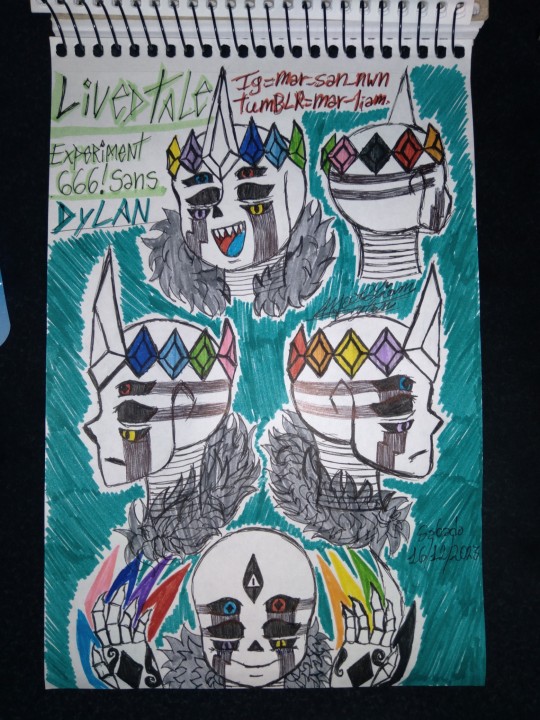
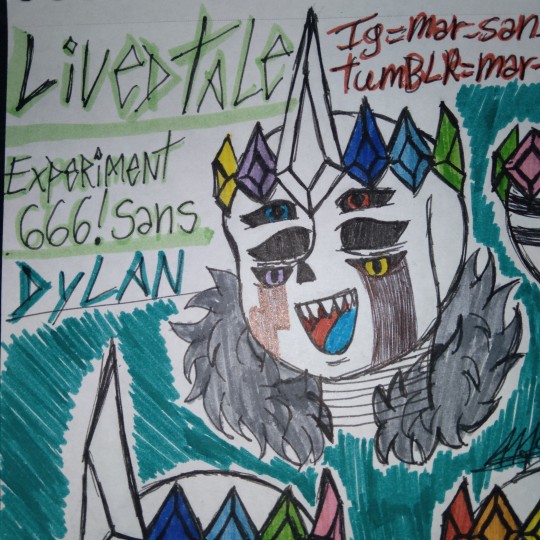
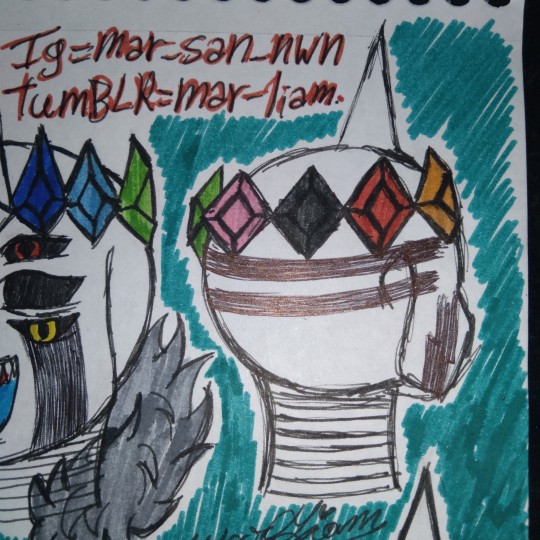
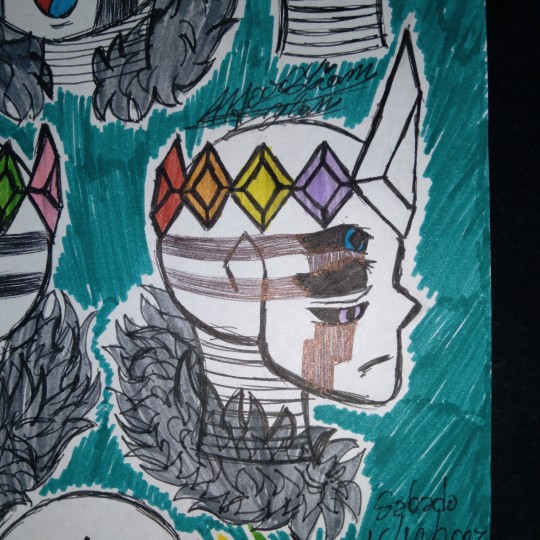


#undertale aus#undertale#dibujo#dibujo tradicional#parati#sans au#livedtalesans#livedtale dylan#livedtale#experiment666sans#experimentó 666#sans oc#fandom undertale#dylan sans
1 note
·
View note
Text
17mil apenas no primeiro capítulo kkkkkkk me empolguei
1 note
·
View note